Charles Wells (1863-1876)
 03 June 1876 - Croydon Advertiser and East Surrey Reporter
03 June 1876 - Croydon Advertiser and East Surrey Reporter
Another Suicide - Another False Charge Claim
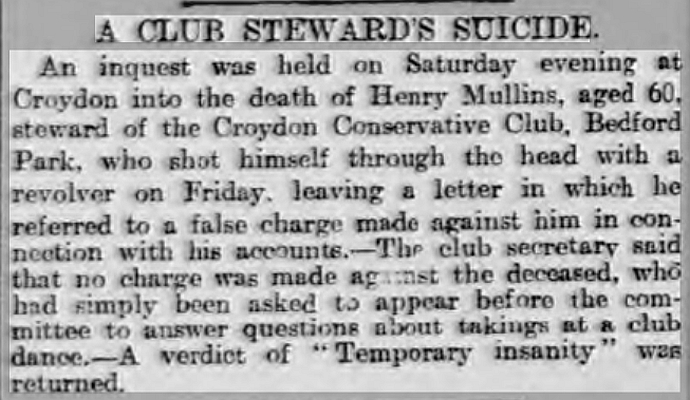 Nottingham Evening Post 08 May 1899
Nottingham Evening Post 08 May 1899
I don't know if the Conservative Club was the same building as Samuel Wells's Surrey Club. If it wasn't then it would only have been as stone's throw away. This case seems very similar to the Charles Wells case. Henry Mullins had been a sergeant-major in the Royal Horse Artillery and he had served in India. As usual Ambrose Bierce got it right when he defined fidelity as "A virtue peculiar to those who are about to be betrayed."
"Broken hearted at his father's conduct"
Charles Wells was treated unfairly and I believe he was sacrificed for a principle. I don't know if this principle has a name but I think of it as extreme altruism. The concerns of "the other" are put before those of the self and also before the concerns of members of the self's family or social group. Altruism is forced on them whether they want it or not. It is a kind of reverse tribalism. "The other" is believed rather than the son because it would be unfair to take the side of one's kin.
We don't know what really happened. The housekeeper claimed the boy had done something to the child. I don't think what he is supposed to have done is what we would assume from the words "behaved improperly" today. After all the father said it was not a serious thing. I would guess that the child was pushed over or fell over and then the housekeeper blamed the boy. In those days, and still to some extent today, an adult's word would always be believed rather than a child's - even if it is your own child. Charles Wells saw that as a terrible lack of loyalty by his father.
Samuel Wells was a Conservative Party Agent in Croydon and I see so many parallels between his behaviour and that of many of his ilk on the national and local level. It is not just the Conservatives. Peter Saunders in his Croydon book wrote about the tension "highlighted between the idealism, universalism and principles of the Labour Group and the materialism, parochialism and pragmatism of the representatives of the town's council tenants". One Labour Councillor said of these people "They don't matter. They've become individualistic." .
Samuel Wells owned the Surrey Club which had previously been the Prince of Wales Hotel. Although Wells was a Conservative Party Agent when the club started it was not political. For example, Jabez Balfour was a prominent member and he was a Liberal. Wells and his wife lived in the club and his children lived at 1 Wellesley Terrace with a housekeeper and her children. Wellesley Terrace consisted of three small houses on Wellesley Road between Bedford Park and St Marys Catholic Church.
The month after Charles's death it seems that life was carrying on as usual for Samuel Wells, but it must be remembered that he had a large family to support and at that time to lose a child was common.
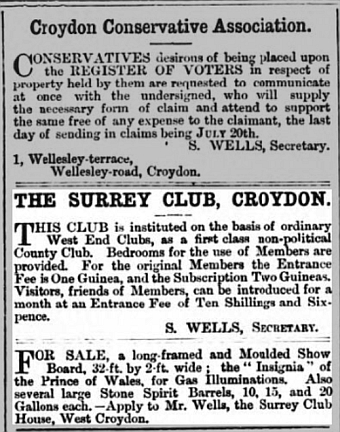 Croydon Advertiser and East Surrey Reporter 15 July 1876
Croydon Advertiser and East Surrey Reporter 15 July 1876
I tried to find out what happened to Samuel Wells and his family after that tragedy and I was astonished to discover that Charles Wells's sister-in-law, Minnie Sophia, died as recently as 1976.
Samuel Wells (1833-1908) and his wife Emily (1844-1893) seemed to move around quite a lot. In 1871 they were living in Mill Street, Bedford. Some of the houses on the street from that date are still there but Samuel's house has been replaced by a modern building. He was described in the census as an "Ale Merchant" which I imagine means a publican. He was declared bankrupt in 1872 and he gave up the licence to run a pub. In 1869 he had been declared bankrupt when he owned a company on the City Road, London. The 1871 census showed that he had five children - Charles (1863), Horace(1866), George (1868), William (1870) and Frederick(1871). Horace died in Bedford in 1872 aged just 6.
In the 1881 census, five years after Charles's death, Samuel is shown on the census as living in Camberwell and is described as a "Commission Agent". There are now three more children - Alice (1874), Herbert(1875) and Edgar(1879).
In 1891 they are living in Norfolk Road, Hackney. He is described as a civil and mining engineer and there is now another child - Emily(1882). All the remaining children are still living at home. They are aged between 23 and 9.
According to the 1901 census Samuel, aged 67, was living a large detached house in Stoke Newington with his second wife, aged 55, and a domestic servant. The house is still there and it looks quite impressive. His first wife had died in 1893, all the children had left home and he was now retired and well off. Despite the apparent ease of his situation I imagine his fireside hours were haunted by the memory of him manhandling Charles's little figure to the gate and sending him down Wellesley Road to his death. The Victorians were inured to the sadness of losing children and they were also comforted by religious beliefs, but I doubt if Samuel ever forgave himself for that.
By looking at the lives of Charles's siblings I thought I would get an idea about the kind of life he would have led if he had not killed himself.
After the two eldest children of this unlucky family had died George became the eldest child. He seems to have done well as an accountant working in east London. In 1897 he married Emma Turner in 1893 and they had one child - Dorothy Gladys - I think. They lived in Hackney. Their daughter Dorothy Gladys Wells married in 1926 and had two children. She lived in east London and she died in 1992 aged 94, almost 116 years after the death of her uncle. She had several grandchildren. I don't know when her parents died, but they were living in east London in 1939.
The next child after George was William Mason Wells. He married Lylie Luretta Spencer in 1895 and they had one child Arthur Spencer Wells who was born in 1900. They lived in Palmers Green and William worked as a travelling salesman in the timber industry. Their house is still there but all the family died young. William Wells died in 1910 aged 41. After this his son went to live with his uncle Percy Edgar Wells in Croydon. Arthur joined the navy in the First World War and died in 1916 when his ship HMS Nasturtium hit a mine off the coast of Malta. He was aged just 16. His mother died aged 48 in 1918.
The brother after William was Frederick Ernest Wells. He married Edith Boorman Lansdell in 1897. Frederick was a salesman in the building industry. He died in Tunbridge Wells aged 78 in 1949. He had 5 children - Dorreen (1898), Winifred (1901), Sydney (1907), Kitty (1911) and a child who died young whose name I don't know. Doreen emigrated to Queensland, Australia and had several children and grandchildren. She died in 1968. Kitty Ruth Wells died single in Bradford in 1999 aged 88. This was 123 years after her uncle Charles had died.
The following picture of Frederick gives us a good idea of how his brother Charles would have looked if he had lived :
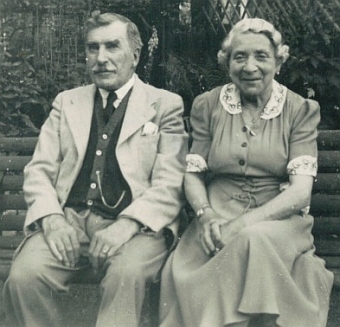 Frederick Ernest Wells (1871-1949) and his wife Edith
Frederick Ernest Wells (1871-1949) and his wife Edith
His son Sydney has similar features :
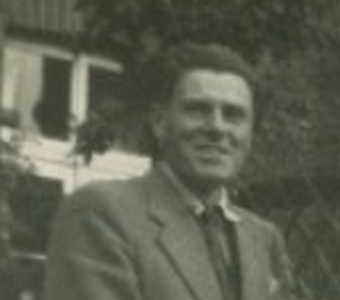 Sydney Wells (1907-1988)
Sydney Wells (1907-1988)
Charles would have been a little older than his nephew Sydney (see below) when he died.
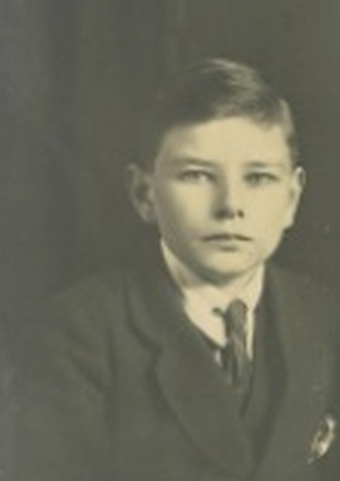 Sydney Wells (1907-1988) c1918
Sydney Wells (1907-1988) c1918
The next eldest to Frederick were Alice Maude Wells and Herbert Owen Wells who married Minnie Sophia Frier in 1902. In 1911 Herbert was living with his wife, his sister Alice Maud and his two children - Raymond (1909) and Irene (1907) - in Ilford. Alice Maud was a 37 year old unmarried waitress and Herbert was a salesman. Herbert was born in Wellesley Terrace the year before Charles's death so he would not have remembered him, but I have no doubt that his brother's death would have been talked about many times in his presence by his siblings and parents. It would have been a family memory passed on to his wife Minnie Sophia and their children.
When we die we live on in the memories of our relatives and our contacts but when these people die we disappear like dust in the wind. There comes a point when if it wasn't for written archives we would be completely forgotten. A comment on a genealogical site by one of Minnie's descendants suggests that point has arrived for Charles. Herbert died in Wood Green in 1947 and Minnie Sophia died in Enfield in 1976.
Percy Edgar was the youngest boy. He was born in Dulwich in 1879 which meant the family must have left Croydon within a few years of Charles's death. The 1911 census shows that Percy was living in Thornton Heath, Croydon not far from the family's old house at Wellesley Terrace. Percy married Annie Langley in 1905 and he worked as an accountant. I think they had two children - Brian (1920) and Georgina (1924)- and, as I have already mentioned, they looked after Percy's nephew Arthur when his father died. Percy died in Bromley in 1951.
The youngest of Charles's siblings was Emily Rose Wells. She was born in Canonbury in 1882 and she is in the 1891 census but I don't know what happened to her after that.
